Tough
Bushes and Grasses that Grow in Nevada
Lilies

Debbie
is
definitely showing some latent talent in photography.
This
lily has bloomed every year since I can remember. It is a
south eastern exposure
which probably helps. It gets no special care other than
summer watering.
The photo is not retouched.
Tamarisks
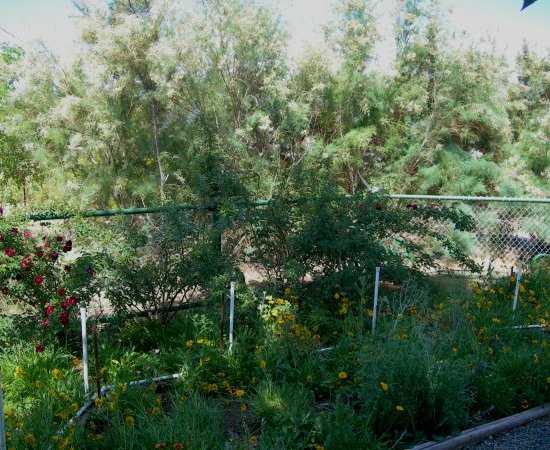
I
needed something to provide a wind break for the vegetation we were
trying to grow.
It had to be cheap, drought resistant and a reasonably fast grower.
East
of Reno about 30 miles is an area that is geothermally active.
Growing
in geothermal mud were tamarisks. How is that for tough?
I
took eight or ten large trash bags to the area and pulled out a number
of four to
five foot tall tamarisks which came up roots and all without any
trouble because the
roots were in warm mud. One had a root over ten feet long.
I dug a number of holes and planted the tamerisks. I coiled
really long roots up like
you would a rope and shoved the whole thing down the hole.
It took a few years but I ended up with a good wind break.
There have been days
of thirty - fifty mile per hour winds and you look out and barely a
breeze gets to the
flower beds.
I figure there are three different species of tamerisks out there.
Tamarisk is invasive
in water ways and other very moist areas so that should be taken into
consideration before
planting.
Tamarisk
flowers range from white to pink.
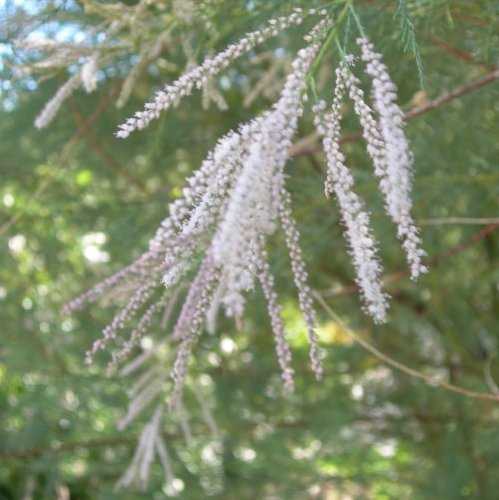 |
| White Flowers |
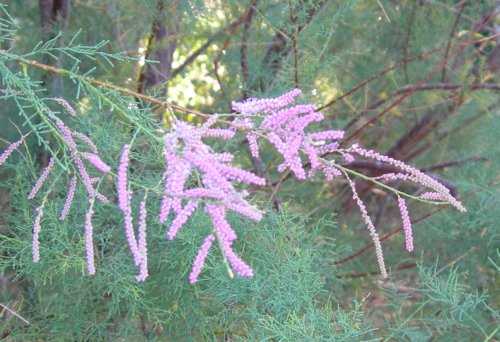 |
| Pink Flowers |
Grasses and
Yucca

Cortaderia
selloana ‘Pumila’ Dwarf Pampas Grass
We
were interested in getting some ornamental grasses and yuccas.
All the expensive
ones we ordered died.
That idea was put on hold until we went out to Walmart one
day and found three one-gallon containers of unlabeled grasses for ten
dollars - another
summer closeout sale.
April 07 Update -
These grasses have been identified:
Cortaderia selloana
‘Pumila’ Dwarf Pampas Grass
The grasses have been moved around several times and we ended up with
five of them.
They are about five feet in diameter and have feathery plumes
in the fall that reach seven
feet in height. Still not sure exactly what kind of grasses
they are but they do well and are
probably eight or nine years old.
The yuccas pictured are Adam's Needle. These were purchased
at a bargain basement sale
and have done quite well. The foliage isn't that attractive looking but
the summer blooms
are impressive.
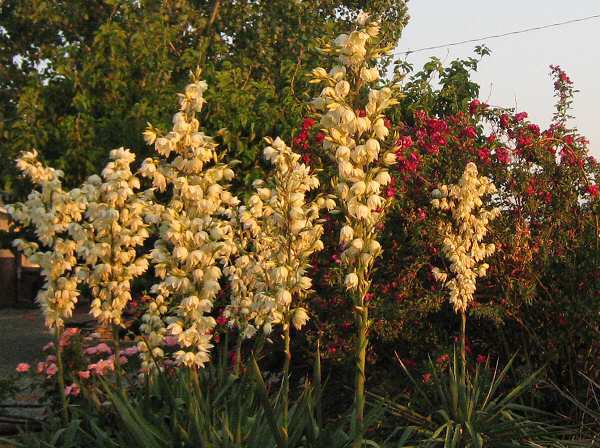
Adam's Needle Flowers.

Silver Stripe Bamboo also does well here if given some water.
I bought a two foot
'bowl' (for lack of a better term) of it about five years ago.
This is another invasive
species and I figured it could invade all it wanted. Well, I
think next year I will have
to do some culm removal.
The grass to the left are what is left of two $50.00 Pampas Grass
plants
guaranteed
of course to grow in Nevada. It is finally doing ok after
eight or nine years.
The dog in front is a Louisiana Catahoula Leopard Dog. It
does
well in Nevada but
the sun has taken its toll on the fair skin. If we get
another, it will be a blue leopard
instead of the red. They are tough, smart dogs and are quite
protective - especially
against the neighbors cats.
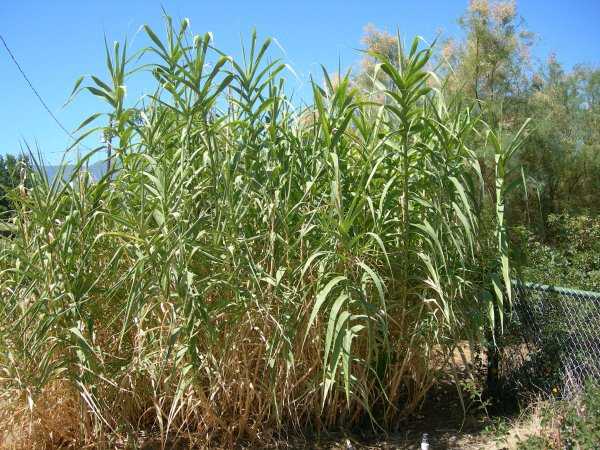
September 4, 2006 - Some of this is approaching 10 feet tall.
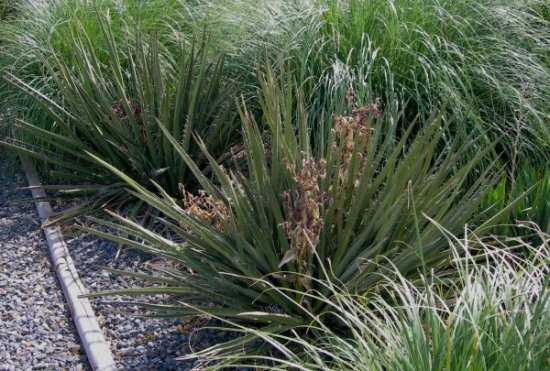
Yucca baccata
These two yuccas were expensive. I don't always cheap out -
even though it is a good idea.
They cost about twenty five dollars each and are about seven years old.
The leaves are stiff and the ends sharp. Pieces of the leaves curl on
the edges making
it look like the leaf has a border of white curly q's.
I don't remember what species these are but it looks like one day I
will have to think
about getting in there and removing some of the babies.
I think
these two Yuccas may be similar to Spanish Bayonet (Yucca faxoniana)
but
they do not grow up, they grow out. Any help on plant ID
would be appreciated.
04-07 - Carol was kind enough to write and tell me that this Yucca is more than likely
Yucca baccata - which I am 99% sure that it is. Thanks,
Carol. I'll go with that. I need to do some thinning
and if someone has experience as to exactly how to do that, I would appreciate that as well.
I'm thinking cut all the leaves way down so there are no spikes to contend with and then dig the clump out
and manually pull them apart. Is there a better way perhaps?
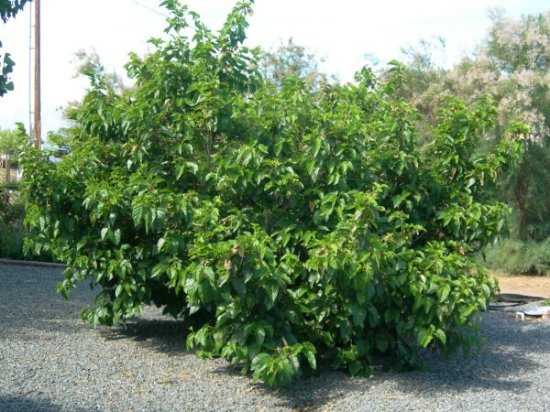
One day rather jokingly we thought we would get a specimen bush and
bought a
Harry Lauder's Walking Stick. It was rather large and rather
expensive. It didn't make
it through the first winter. (Took me a while to learn the
'expensive' thing).
So, the following year we thought rather jokingly that we would try
another specimen bush.
One of the bargain catalogs had what they called a Contorted Filbert
for less than five
dollars. It actually survived. The filbert is about nine years old and
it is contorted.
I am not exactly sure how large they get but it is nice to see
something large, leafy
and green anytime. It does have a tendency to get zapped by
late frosts or snow showers
like what happened this latest Memorial Day weekend but it does recover.
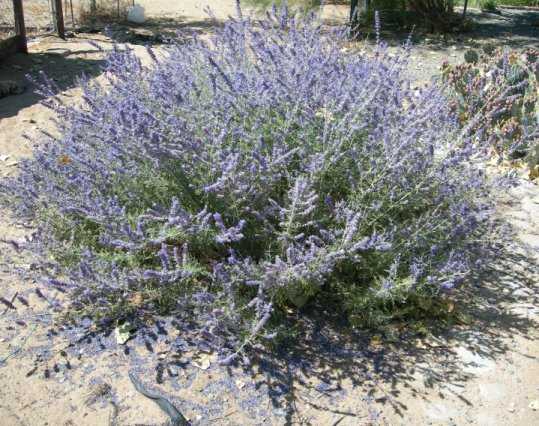
This is Russian Sage and it is just coming into bloom. It is
hard to kill unless you
try to move it. Sage is attractive and fragrant.
Needs very little water and is quite hardy.
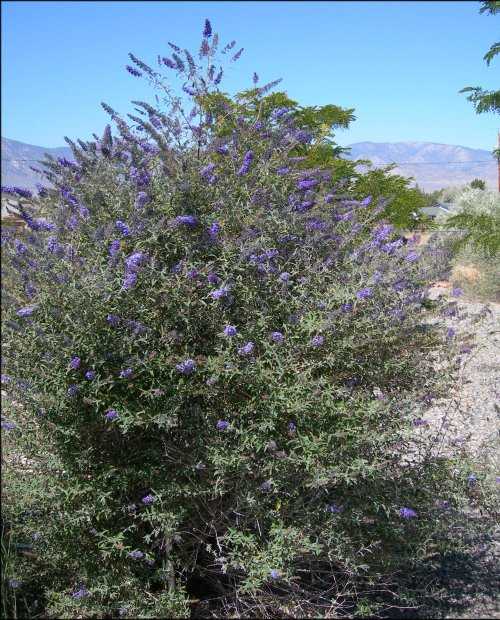
Black Knight Butterfly Bush is a favorite with the nectar sucking crowd.
This particular bush is about eight years old. I think this
next year I am
going to give it a severe trimming.
I tried several other species of Butterfly bush and did not have much
luck.
This one survives through thick and thin. I highly recommend
it.

Yarrow also does well. It is kind of funny though;
I originally had predominantly yellow yarrow
and over the years it has morphed into blue / white Yarrow.
It changes from year to year.
Never seems to take over or anything - just changes color.
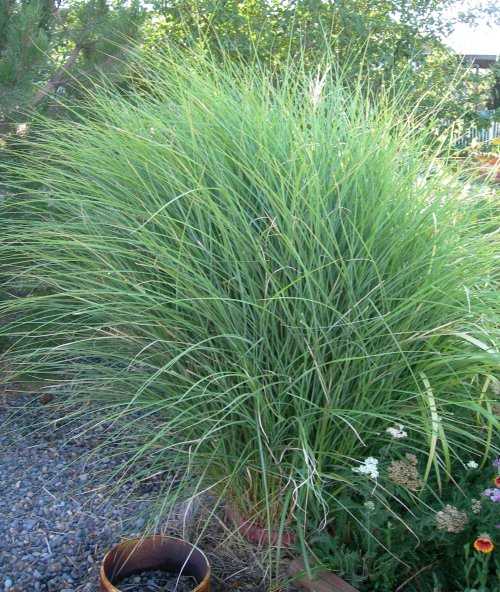
I have one chunk of fountain grass (may be fairy grass). It
has never spread,
never died, never done anything obnoxious. It simply grows
and displays some
nice flowers in the fall. I recommend it.

For the last ten years we always have had a sunflower patch.
We pretty much ignored
the rule about rotating your crops every year and ended up getting a
fungus that would
girdle the sunflower several inches above the base. We ended
up with a huge mortality
rate.
So, we decided to turn the sunflower patch into an Oregon patch.
The sunflower pictured here is from the original patch and so far
nothing has attacked it.
An interesting thing..... notice at the bottom of the sunflower seed
head are several
bees. They spend the night in this position, ready to
continue harvesting pollen in the morning.
Sunflowers - I say go for it, but rotate to something different every
few years.
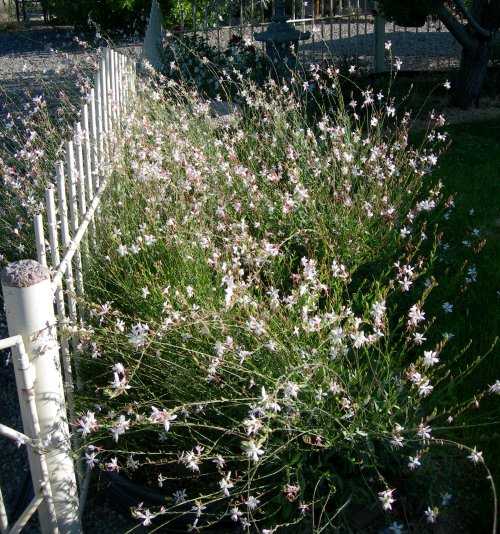
Whirling Butterflies are awesome in this climate, particularly during
the mid-afternoon
Sierran wind blasts. They are very attractive and winter
over well.
I am a big believer in the use of chemicals. I don't believe
in the stuff that controls.
I don't want control, I want dead.
This patch was overrun with grass and before I discovered 'Grass
Getter', I finally
resorted to pulling everything out of the patch and started over.
I could not find any Whirling Butterfly 'roots', but I did find these
items that looked like
red bark with sprouts on them. The oddest looking stuff.
Should have taken a couple pictures.
I tossed all this into the wheel barrow until I ran across one that had
some leaves that sure
looked like a Whirling Butterfly leaf.
Well, I promptly pulled all the root looking things back out, broke
them up and replanted them.
The end result was what is pictured here.
Two thumbs up for this selection in Northern Nevada Climates.
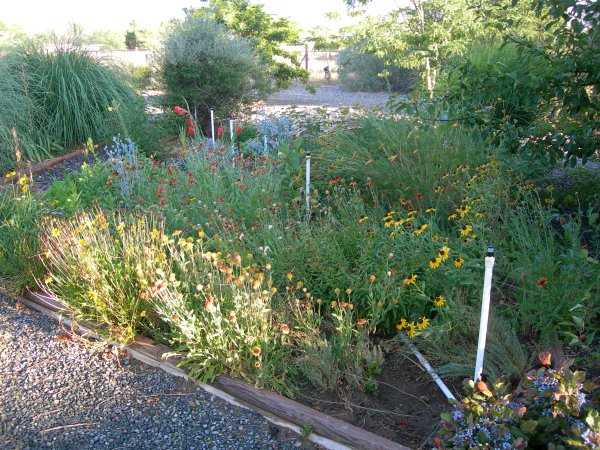
The Wild Flower patch is about ten years old. It replaces a
patch of Rabbit Brush.
In for forefront is Oregon Grape. Various bulbs, annuals and
perennials make up the
rest of the patch.
I pretty much let it do whatever it wants to do. Some years I
throw a Walmart seed
mixture in there to see if anything different sprouts. Maybe
that's where the
Red Hot Poker came from.
It gets watered every day for fifteen minutes in the morning and does
ok.
There was a huge problem with noxious grasses until I discovered 'Grass
Getter' and
now believe it or not, the ongoing problem continues to be Swiss Chard.

Don't ask me how, I don't know either.
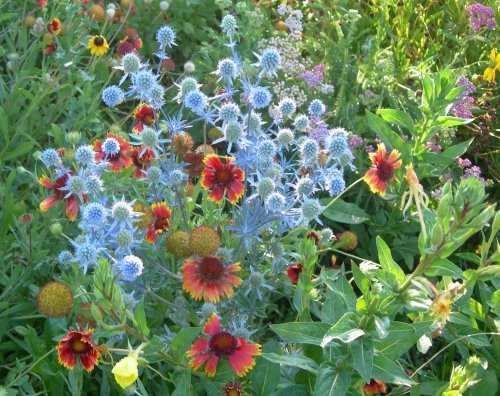
Eryngium, or Sea Holly was quite the experience. Some years
ago I got a package
of six tubers, three different Sea Holly species. They were
six dollars apiece.
They all died - except one.
These
things do not transplant well. They have a very deep tuber.
Fast forward to the present and there are probably fifty plus Sea Holly
plants.
They look kind of like a turquoise colored tumbleweed.
Sea Hollies are quite the rage with all the pollinators. It
is amazing to see the variety
of insects on this plant at any given time.
They have no scent that I can detect.
Eryngium winters well and is drought, sun, wind and generally otherwise
resistant.
It seems to have no natural pests.
I recommend the plant.
What I would do though, is find someone who is growing the species of
your choice,
ask to collect the bushes after they go to seed and spread the seeds
throughout the
area you wish to populate. Crush the bush and spread that out
too.
It might not be the first year, but by the second year you should a few
coming up.
After that, let them seed themselves.
If you wish to buy them, buy them grown locally in pots.
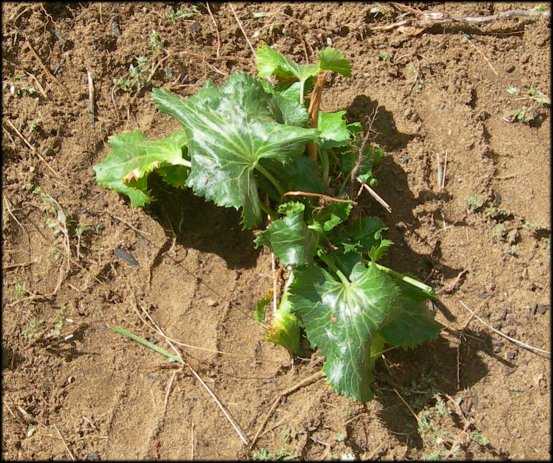
This is an example of a pot grown sea holly (Eryngium Blue Diamond)
I bought September, 2006. This species makes great cut
flowers.
Will it survive the winter?
Lets see..... planted in September, 95 degrees outside, still alive in
the pot,
a b@#$h to get started........maybe.

This is another Louisiana Catahoula Leopard Dog. They do
quite well in Nevada as
long as they get lots of attention and have a rocking chair relax in.
This one is over
nine years old and still quite agile. The tummy skin is
problematic though.
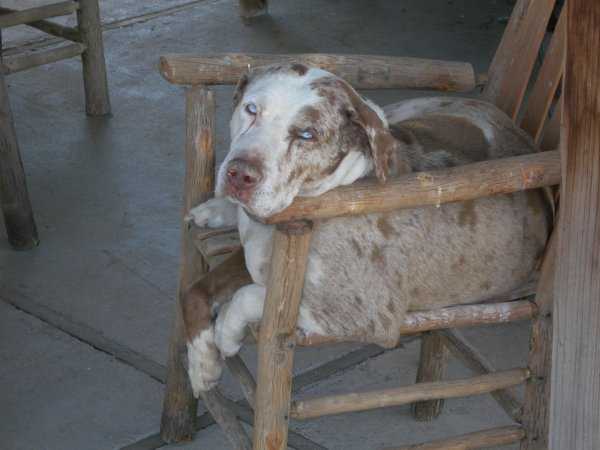
Absent a rocking chair, a standard chair will do.

























